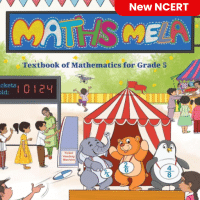Class 5 Exam > Class 5 Questions > _____________ objects cast shadows.a)Transpar...
Start Learning for Free
_____________ objects cast shadows.
- a)Transparent
- b)Translucent
- c)Opaque
- d)Both A and C
Correct answer is option 'C'. Can you explain this answer?
Most Upvoted Answer
_____________ objects cast shadows.a)Transparentb)Translucentc)Opaqued...
Explanation:
When an object obstructs the path of light, it creates an area of shadow behind it. The nature of the object determines the type of shadow it will cast. Let us see how different types of objects cast shadows.
Opaque Objects:
Opaque objects are those that do not allow light to pass through them. When light falls on an opaque object, it casts a dark shadow behind it. The shadow is formed because the light is blocked by the object, and it cannot pass through it. Examples of opaque objects are a wall, a table, a book, etc.
Transparent Objects:
Transparent objects are those that allow light to pass through them. When light falls on a transparent object, it passes through it and does not cast a shadow. The light that passes through the object creates a bright spot on the surface behind it. Examples of transparent objects are glass, water, etc.
Translucent Objects:
Translucent objects are those that allow some light to pass through them. When light falls on a translucent object, it scatters in different directions, and a fuzzy shadow is formed behind it. The shadow is not as dark as that of an opaque object because some light passes through the object. Examples of translucent objects are frosted glass, wax paper, etc.
Conclusion:
Therefore, the correct answer to the question is option 'C', which states that opaque objects cast shadows. Opaque objects are those that do not allow light to pass through them, which creates an area of shadow behind them. Transparent and translucent objects do not cast shadows or create fuzzy shadows, respectively.
When an object obstructs the path of light, it creates an area of shadow behind it. The nature of the object determines the type of shadow it will cast. Let us see how different types of objects cast shadows.
Opaque Objects:
Opaque objects are those that do not allow light to pass through them. When light falls on an opaque object, it casts a dark shadow behind it. The shadow is formed because the light is blocked by the object, and it cannot pass through it. Examples of opaque objects are a wall, a table, a book, etc.
Transparent Objects:
Transparent objects are those that allow light to pass through them. When light falls on a transparent object, it passes through it and does not cast a shadow. The light that passes through the object creates a bright spot on the surface behind it. Examples of transparent objects are glass, water, etc.
Translucent Objects:
Translucent objects are those that allow some light to pass through them. When light falls on a translucent object, it scatters in different directions, and a fuzzy shadow is formed behind it. The shadow is not as dark as that of an opaque object because some light passes through the object. Examples of translucent objects are frosted glass, wax paper, etc.
Conclusion:
Therefore, the correct answer to the question is option 'C', which states that opaque objects cast shadows. Opaque objects are those that do not allow light to pass through them, which creates an area of shadow behind them. Transparent and translucent objects do not cast shadows or create fuzzy shadows, respectively.
Free Test
FREE
| Start Free Test |
Community Answer
_____________ objects cast shadows.a)Transparentb)Translucentc)Opaqued...
Opaque Objects Cast Shadows
Opaque objects are those that do not allow light to pass through them. When a light source shines on an opaque object, it creates a shadow on the surface behind it. This is because the light rays are blocked by the object, preventing them from reaching the surface behind it.
Translucent and Transparent Objects
Translucent and transparent objects allow light to pass through them, but in different ways. Translucent objects allow some light to pass through but scatter it in different directions, making the object appear blurry. Transparent objects allow all light to pass through them, making them appear clear and easy to see through.
No Shadows Are Cast
Since translucent and transparent objects allow light to pass through them, they do not cast shadows. The light passes through the object and continues on its path without being blocked, so there is no shadow created on the surface behind the object.
Conclusion
Opaque objects are the only ones that cast shadows because they block the light from passing through them. Translucent and transparent objects allow light to pass through them, so no shadows are created. Understanding these differences can help us understand how light behaves and interacts with different objects in our world.
Opaque objects are those that do not allow light to pass through them. When a light source shines on an opaque object, it creates a shadow on the surface behind it. This is because the light rays are blocked by the object, preventing them from reaching the surface behind it.
Translucent and Transparent Objects
Translucent and transparent objects allow light to pass through them, but in different ways. Translucent objects allow some light to pass through but scatter it in different directions, making the object appear blurry. Transparent objects allow all light to pass through them, making them appear clear and easy to see through.
No Shadows Are Cast
Since translucent and transparent objects allow light to pass through them, they do not cast shadows. The light passes through the object and continues on its path without being blocked, so there is no shadow created on the surface behind the object.
Conclusion
Opaque objects are the only ones that cast shadows because they block the light from passing through them. Translucent and transparent objects allow light to pass through them, so no shadows are created. Understanding these differences can help us understand how light behaves and interacts with different objects in our world.

|
Explore Courses for Class 5 exam
|

|
Question Description
_____________ objects cast shadows.a)Transparentb)Translucentc)Opaqued)Both A and CCorrect answer is option 'C'. Can you explain this answer? for Class 5 2025 is part of Class 5 preparation. The Question and answers have been prepared according to the Class 5 exam syllabus. Information about _____________ objects cast shadows.a)Transparentb)Translucentc)Opaqued)Both A and CCorrect answer is option 'C'. Can you explain this answer? covers all topics & solutions for Class 5 2025 Exam. Find important definitions, questions, meanings, examples, exercises and tests below for _____________ objects cast shadows.a)Transparentb)Translucentc)Opaqued)Both A and CCorrect answer is option 'C'. Can you explain this answer?.
_____________ objects cast shadows.a)Transparentb)Translucentc)Opaqued)Both A and CCorrect answer is option 'C'. Can you explain this answer? for Class 5 2025 is part of Class 5 preparation. The Question and answers have been prepared according to the Class 5 exam syllabus. Information about _____________ objects cast shadows.a)Transparentb)Translucentc)Opaqued)Both A and CCorrect answer is option 'C'. Can you explain this answer? covers all topics & solutions for Class 5 2025 Exam. Find important definitions, questions, meanings, examples, exercises and tests below for _____________ objects cast shadows.a)Transparentb)Translucentc)Opaqued)Both A and CCorrect answer is option 'C'. Can you explain this answer?.
Solutions for _____________ objects cast shadows.a)Transparentb)Translucentc)Opaqued)Both A and CCorrect answer is option 'C'. Can you explain this answer? in English & in Hindi are available as part of our courses for Class 5.
Download more important topics, notes, lectures and mock test series for Class 5 Exam by signing up for free.
Here you can find the meaning of _____________ objects cast shadows.a)Transparentb)Translucentc)Opaqued)Both A and CCorrect answer is option 'C'. Can you explain this answer? defined & explained in the simplest way possible. Besides giving the explanation of
_____________ objects cast shadows.a)Transparentb)Translucentc)Opaqued)Both A and CCorrect answer is option 'C'. Can you explain this answer?, a detailed solution for _____________ objects cast shadows.a)Transparentb)Translucentc)Opaqued)Both A and CCorrect answer is option 'C'. Can you explain this answer? has been provided alongside types of _____________ objects cast shadows.a)Transparentb)Translucentc)Opaqued)Both A and CCorrect answer is option 'C'. Can you explain this answer? theory, EduRev gives you an
ample number of questions to practice _____________ objects cast shadows.a)Transparentb)Translucentc)Opaqued)Both A and CCorrect answer is option 'C'. Can you explain this answer? tests, examples and also practice Class 5 tests.

|
Explore Courses for Class 5 exam
|

|
Signup for Free!
Signup to see your scores go up within 7 days! Learn & Practice with 1000+ FREE Notes, Videos & Tests.























